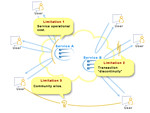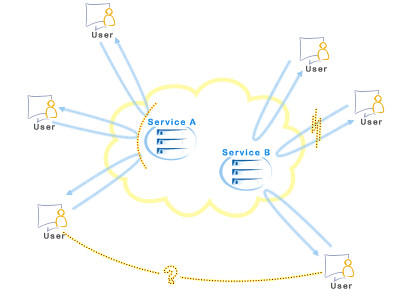P2P for Web 2.0: Brainstorming
January 17th, 2006 by jeremychone |
As mentioned in the "Web 0.x to Web 2.0" post, outside of IM (instant messaging), voice chat and voice-video chat, and some illegal P2P (peer to peer) file sharing software, most Internet applications are still based on a traditional "Client/Server" model that is analogous to the "Browser/WebServer" model. While today’s Web applications have dramatically improved their user experience and community aspect, this "Client/Server" paradigm brings some unfortunate limitations to technology providers and users. |
Current Web application model limitations:
For technology providers, although the cost of development of a internet service might be relatively low, operational costs, mostly related to bandwidth and storage, severely limit what can be offered to users. For example, providing an entirely free mainstream photo, audio, and video sharing Internet application would require continuous investment that would be hard to justify outside of an monopolistic business strategy.
From the user‘s point of view, while the "zero install" feature of the Web application model is advantageous, it also has the drawback of a "zero memory" limitation (at least as it relates to Internet requests). This means that an interrupted transaction (i.e., Internet request) is a lost transaction. While this is not really an issue for small requests (e.g., eBay bid, craigslist post), it could be quite frustrating for users performing more involved tasks, such as sharing videos.
Also, although today’s new Web trend (Web 2.0) encourages the social aspect of these services, I think that most of the current Web 2.0 applications are still primarily focused on the "tech-savvy" population and have not yet reached the "mainstream." One of my current explanations for this assumption is that "mainstream" users tend to prefer participating with their adjacent network first (friends and family) first, which has been cumbersome given the current proliferation of user identity silos.
P2P Opportunities:
While P2P is definitely not the magic pixie dust to solve all of these problems, combining the P2P paradigm with the traditional Web application model could open the door to many interesting innovations and offer the following advantages:
- Reduced operational cost: By the very nature of P2P architecture, P2P technology providers can offload most of the service processing to their end-users, allowing providers to just centralize what matters to them most (usually the directory service), while offering more attractive services to their users. For example, Skype’s P2P approach was probably a big factor in their exponential growth despite their relatively modest financial investment.
- Illusion of continuity : While this is not really a P2P attribute, most of the P2P clients, such as Skype, instant messengers, and file sharing applications, usually support some sort of "transaction recoverability." This means that the client application is usually able to remember an interrupted request and restart it where it left it.
- Network of proximity: One great feature of all IM clients is the "buddy list", which allows users to easily communicate and share with their close network, such as friends and family. I personally think it would be a great step forward if this paradigm could be carried into the user’s Web experience.
As with all technologies, there are many different ways these types of functionalities can be delivered to users. It could come from a better and deeper integration between existing P2P clients, such as Skype or BitTorrent, with existing Internet browsers. Third party browser extensions, such as the promising AllPeers Firefox extension (profiled by Techcrunch), seem also to be headed towards this goal. Or, lastly, it could come from a revolutionary all-in-one client, similar to Groove, but geared for the consumer market.
Related links:
- Great Allpeers article (from Allpeers’ blog) about extension vs standalone.
- Some Skype P2P pitfalls on Om Malik’s blog.
- An interesting take from Muli Koppel about Skype and Web 2.0.

September 1st, 2006 at 6:58 am
Very good reading. Peace until next time.
WaltDe
February 8th, 2009 at 1:53 pm
People really forget how much bandwidth goes in to sites like this and how much of a tab that runs up. I dont even want to think how much a site like Youtube pays in their bandwidth, especially with streaming video. It must be unreal.
February 8th, 2009 at 5:09 pm
Interesting picture. I’ll have to look into this further. Thanks for posting.
February 18th, 2009 at 9:28 am
These are some interesting concepts. I agree with the problem of bandwidth. The costs of running a site like this can cost a lot and in the end there are limited ways of monetizing a site like this.